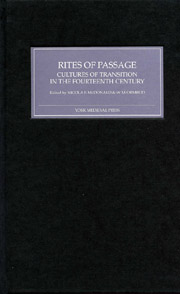Book contents
- Frontmatter
- Contents
- List of Contributors
- Preface
- Introduction: Rites of Passage
- Re-writing a Rite of Passage: The Peculiar Funeral of Edward II
- Coming to Kingship: Boy Kings and the Passage to Power in Fourteenth-Century England
- Boy/Man into Clerk/Priest: The Making of the Late Medieval Clergy
- Manners Maketh Man: Living, Dining and Becoming a Man in the Later Middle Ages
- Rites of Passage in French and English Romances
- Becoming Woman in Chaucer: ‘On ne naît pas femme, on le meurt’
- John Gower's Fear of Flying: Transitional Masculinities in the Confessio Amantis
- ‘Le moment de conclure’: Initiation as Retrospection in Froissart's Dits amoureux
- Index
- YORK MEDIEVAL PRESS: PUBLICATIONS
Boy/Man into Clerk/Priest: The Making of the Late Medieval Clergy
Published online by Cambridge University Press: 12 September 2012
- Frontmatter
- Contents
- List of Contributors
- Preface
- Introduction: Rites of Passage
- Re-writing a Rite of Passage: The Peculiar Funeral of Edward II
- Coming to Kingship: Boy Kings and the Passage to Power in Fourteenth-Century England
- Boy/Man into Clerk/Priest: The Making of the Late Medieval Clergy
- Manners Maketh Man: Living, Dining and Becoming a Man in the Later Middle Ages
- Rites of Passage in French and English Romances
- Becoming Woman in Chaucer: ‘On ne naît pas femme, on le meurt’
- John Gower's Fear of Flying: Transitional Masculinities in the Confessio Amantis
- ‘Le moment de conclure’: Initiation as Retrospection in Froissart's Dits amoureux
- Index
- YORK MEDIEVAL PRESS: PUBLICATIONS
Summary
In principle, in fourteenth-century England the process of moving between the status of lay child and that of adult priest was long, and involved submission to a series of rites of passage or initiations. The process, however, was clear and each stage was tied to an age requirement so that the boy progressed from child to adult and lay to priest in a parallel development. The orders had been developed in the early Church and remained accepted through the Middle Ages. In the journey between boy or man and priest, there were seven orders divided between four minor and three major orders, and only once one embarked upon the latter was celibacy a requirement. The minor orders were doorkeeper, exorcist, lector and acolyte; the major orders were generally regarded as sub-deacon, deacon and priest, though some thought deacon, priest and bishop more appropriate. The sub-deacon was somewhat ambivalent as to grade, for until the thirteenth century it had been regarded as a minor order, and there is some evidence to suggest that that was still how it was perceived. The lowest of the minor orders could be received at any time after the age of seven, but none could become an acolyte before the age of fourteen. Entry to the major orders, and hence to the vows of celibacy, took place rather later: eighteen to become a sub-deacon, nineteen for deacon, twenty-four to be a priest.
- Type
- Chapter
- Information
- Rites of PassageCultures of Transition in the Fourteenth Century, pp. 51 - 66Publisher: Boydell & BrewerPrint publication year: 2004



